Xenogears released in 1997: after Final Fantasy VII, before Final Fantasy VIII. At a time when the Square Enix development cycle could stretch to a year and a half (Final Fantasy games included), Xenogears took over two. Even that wasn’t enough, not even close: Xenogears is, at best, 75% complete.
That’s nothing, though. Xenogears is only one part of the saga. I almost didn’t want to start my review with this fact, because it seems like a spoiler… except when you think about it, it can’t be. The “spoiler” is this: after the credits role, Xenogears is revealed to be subtitled “Episode V”. But if another game had been released in the saga as intended, Xenogears existence as the fifth part would now be common knowledge. It’s only because the series was cut short that the placement of this game remains a hidden easter egg.
Xenogears, the complete saga, is only 12.5% complete. And yet, you can feel the weight of those four prequels in the content of Xenogears: Episode V. When people describe this game with grand approbation, that is the truth at the heart of their praise. Xenogears: the most intricate story in videogames; the most ambitious JRPG ever made.
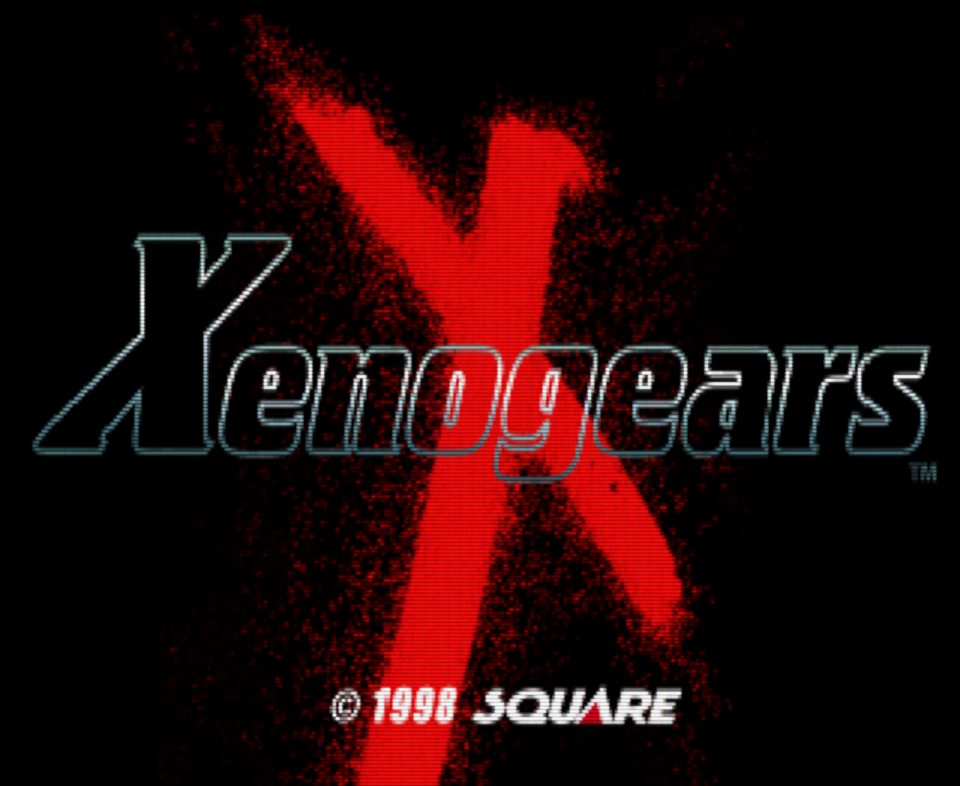
I imagine what Xenogears: Episode V (from here, just Xenogears) might have been it had been fully fleshed out from start to end. The word that comes to mind is “breathtaking”.
Xenogears was conceived by Tetsuya Takahashi and Soraya Saga, husband and wife storytelling superteam. They were inspired by Gundum, Star Wars, and perhaps most obviously, Neon Genesis Evangelion. They were inspired by Freud, Jung, and Neitzche.
Takahashi went on to write the scenario for every Xeno game since, from Xenosaga Episode 1 to Xenoblade Chronicles 3, and Saga is credited for the Xenosaga games. These subsequent games were not the missing Xenogears episodes, though some fans consider the Xenosaga trilogy as an adequate replacement for Xenogears episodes I and II.
Xenogears is a orphan gem, lonely and unique, but it is also something more simple: an incredible game. With the resources of Square in their golden age, who turned out masterpiece after masterpiece in the JRPG genre, it shouldn’t be a surprise that Xenogears is one too.
In fact, this game started life as a pitch for the seventh Final Fantasy game. The gears, so essential to the game that they made their way into the title, started life as summon monsters.
It is extremely interesting to look at Xenogears as an alternative branch of the Final Fantasy series. It builds on the foundations of Final Fantasy VI but develops them in a different way to VII. And when you see the similarities in story between Xenogears and Final Fantasy VII, you have to wonder how much of an influence Takahashi’s story had on the most loved JRPG in history.
I played Xenogears for the first time in 2022. Here are the reasons it blew my mind (and a few reasons it didn’t).
An aesthetic to die for
Xenogears has my favourite character spites of any game.
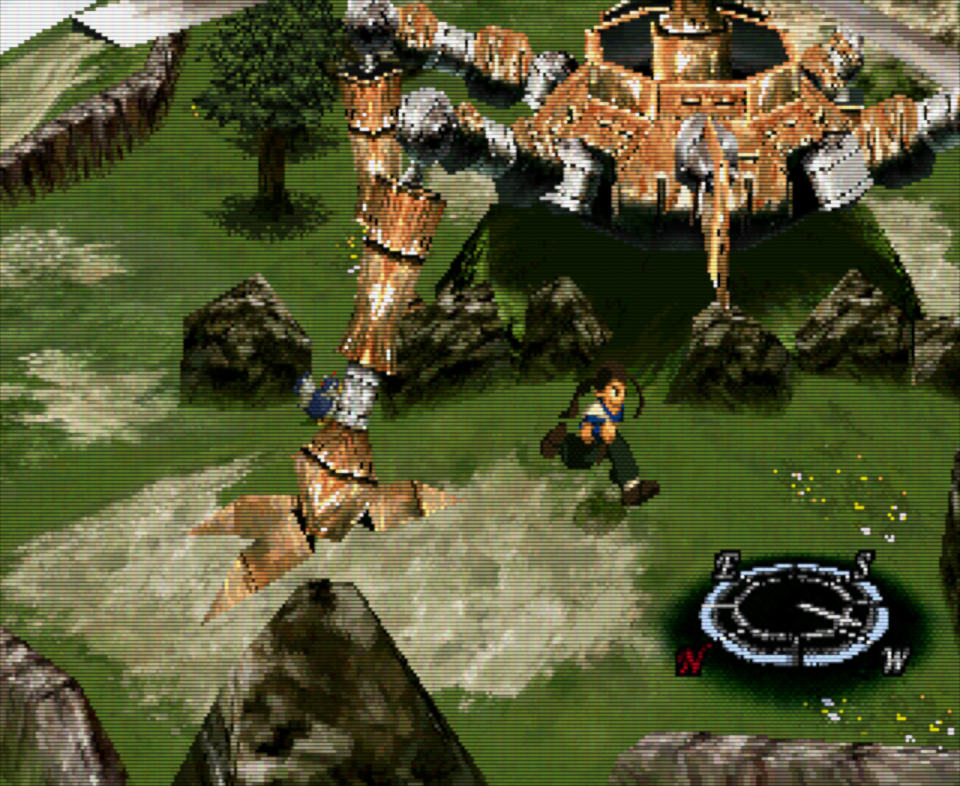
The hair flows, the clothes have volume. Each character has a unique gait and posture that matches their personality. The power in their legs as they run is palpable. This was so unlike the restained movements of SNES-era JRPG, and equally unlike Final Fantasy VII’s stiff limbed 3D characters that had arrived on the scene one year previously.
This is a theme: where Final Fantasy VII zigged, Xenogears zagged. It is stark in their visual presentation. Final Fantasy games on the PS1 have 3D characters against detailed, pre-rendered 2D backgrounds. In Xenogears, it is the environments that are 3D while the characters remain 2D spites.
It was not the only game to do this: Breath of Fire III was another RPG to take this route, and the whimsical Klonoa used the effect with excellent results in the platformer genre, but games with 3D characters were fast becoming the fashion. Therefore, Xenogears represents the heights of its 2.5D style (though HD-2D games like Octopath Traveller have now arrived to challenge that claim).
Mitsuda: Maps used to be one piece of art that characters would stand and move around on, but Xenogears was innovative in that it implemented the ability to move the camera around. The characters are 2D, but the background is all 3D. Because of this, we could try out new gimmicks and new camerawork that was previously not possible. That was what we started with.
Yasunori Mitsuda, Xenogears Composer (2018 Anniversary Concert Interviews)
Xenogears demonstrates the strengths of it’s presentation choice early. By default, it is we see the world at an isometric angle. You spin can spin the camera left and right. But when the moment calls for it, the game will seize the camera from you. In the first village, climb on the roof of your next-door neighbours house: the camera sweeps up to face the horizon, and the birds, sun and mountains come gloriously into sight.
When a game with prerendered graphics, like Final Fantasy, wants to show the sun, a new background has to be drawn from scratch. There is no sweep of the camera, either. This fact also affects cutscenes. Final Fantasy could rely on FMVs when they wanted to deliver an action scene with greater impact, but Xenogears could pulled it all off in-engine.
“Xenogears was innovative in that it implemented the ability to move the camera around. The characters are 2D, but the background is all 3D. Because of this, we could try out new gimmicks and new camerawork that was previously not possible. That was what we started with.”
– Yasunori Mitsuda, Xenogears composer [Source]
As a result, Xenogears regularly has cutscenes with the dynamism and drama of an anime. They are complex, with multiple moving parts, changes in camera angle, dramatic pacing. There is never a cut from gameplay to FMV to break your immersion.
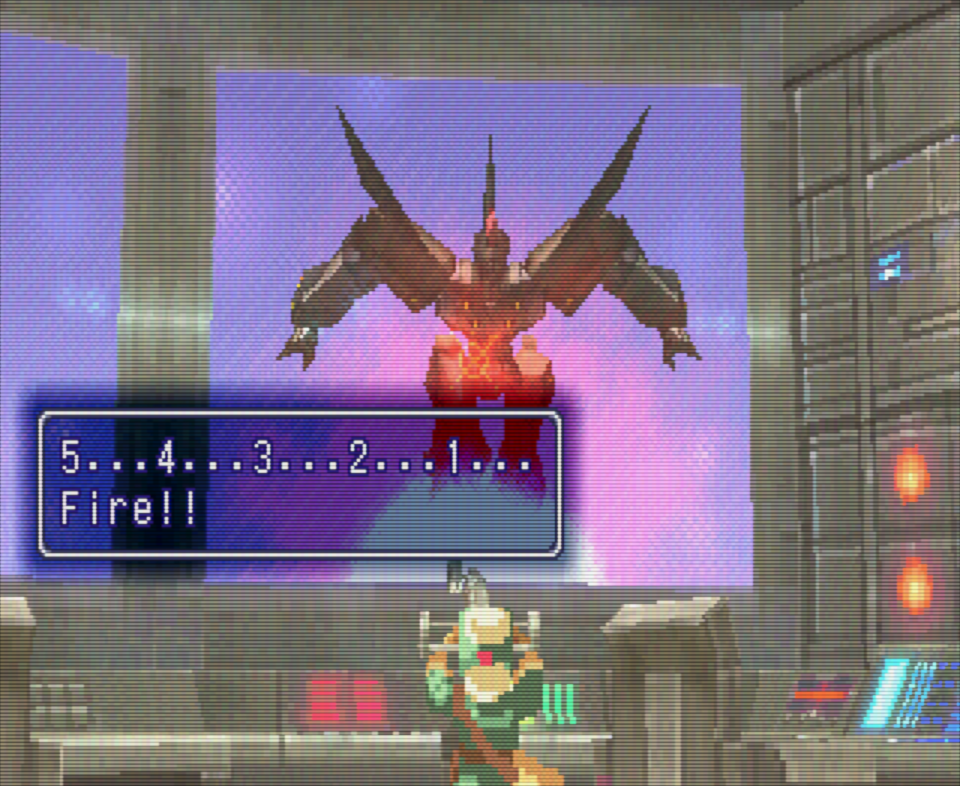
Unlike the characters, the mechs (called “gears” in the game — I’ll stick with mechs so this article is easier to read for those who have not played it yet) are 3D models, but as they are blocky machines to begin with, this doesn’t detract from their design in the slightest. These are mechanical warriors that could take the stage shamelessly in any Gundam show room — and I wrote that line before I realised that Junya Ishigaki, the primary mechanical designer for the game, is also prolific in the Gundam franchise.
The mechs, the character sprites, their portraits, the lived-in details of the environments: they all come together to delight the player. Every location is a perfectly constructed diorama, a sculpture that is fit to be enjoyed from every angle. Every character portrait drawn with a skilled and seductive stroke. Xenogears is visually captivating.
I’ve heard some people describe the visuals of Xenogears and a pixelated mess, and that pains me so much. If you are emulating this game, turn on a CRT filter. It makes more of a difference here than any game I have ever played. It smooths out the textures, smooths out the jaggies, brings the image together and let’s you appreciate the extreme artistry on display.

I can’t exaggerate the number of times I wanted, needed to take a screenshot while playing Xenogears. So many rooms of this game are gorgeous. So many cutscenes are eye catching. There are so many evocative environments, so many unique unique visual effects. You want to experience it at its best.
An anime epic
How many mysteries does Xenogears present in the first hour? We have a anime FMV about spaceship disaster with no context; a text crawl that introduces two mysterious organisations (the Ethos and the Gebler); an amnesiac protagonist and hints about his significant past; that protagonist’s unexplained and dangerous powers that he tragically can’t control; a mysterious figure called Grahf…
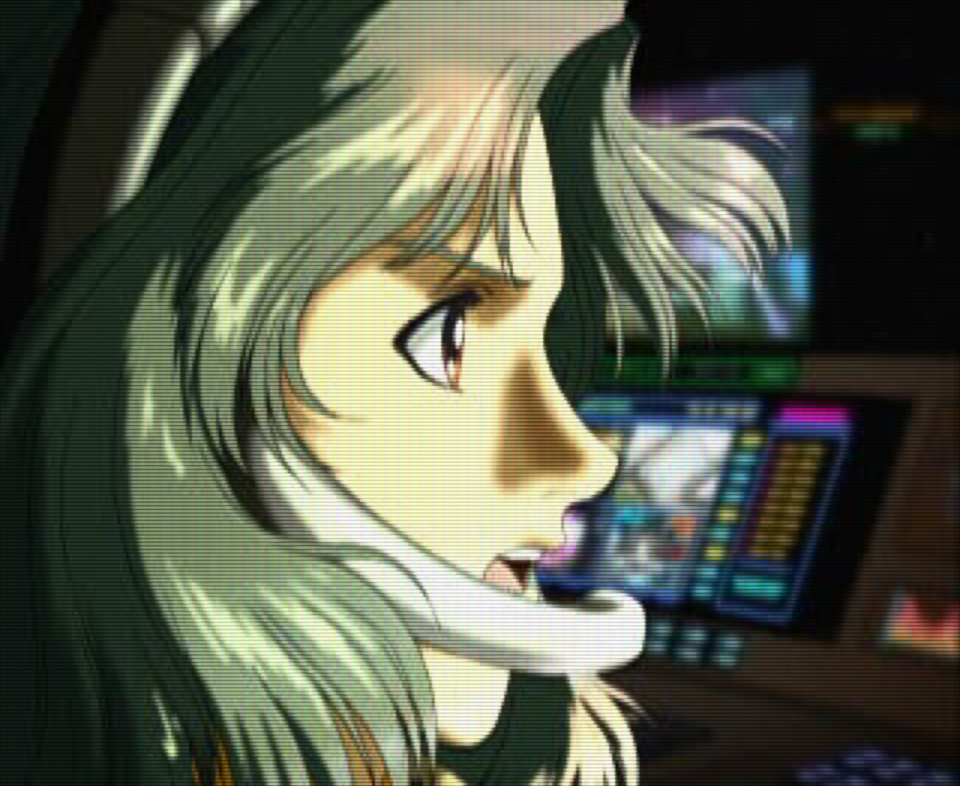
Xenogears is slow to doll out answers to any mystery is introduces. It is known, quintessentially, as a “slow burn” JRPG. Instead of answers, Fei is whisked away to new location after new location, meeting new characters, getting embroiled in new conflicts. The war for Aveh’s capital, the prison block struggle in Nortune, the defence of the floating city, Thames, against the Wels — the list goes on and on. There are unique characters, animations, scenes, plot developments around almost every corner.
Takahashi: I liked mechs and pop culture characters, and I wanted to make a game combining the two. And if I was going to do it, I wanted it to be better than FF, too. I wanted to try my hand at the popular fad at the time of littering the plot with foreshadowing and having all of those storylines coming together for the central story, too.
2018 Anniversary Concert Interviews
Describing Xenogears as just a slow burn does not do it justice. It is a long lasing campfire to warms your story-loving cockles for many hours. It is a story that could easily be repurposed into episodes and mini-arcs of a long-running anime series.
There is always a crisis and a plan. This is fundamental story telling, but it works. The crisis shunts the heroes to somewhere new — a deadly foe is chasing you across the desert, a dictator has taken control of your friend’s home city, a battle goes wrong and somebody is dreadfully injured, warring factions coalesce on your location. Rarely a dull moment.
More than the crisis, the stories of Xenogears are elevated by its smart and active characters. They come to the table with different goals and attitudes. Bart is brash, passionate, and funny. Citan is calm and calculating. They talk over the latest crisis, asking questions about possible issues with their course of action. They unfurl a map.
This is the intersection of a plot driven story and a character driven story. Unfortunately, not all characters are as fleshed out as others, but every one of the playable roster is worthy of your consideration (except Chu-Chu?).
Takahashi and Saga’s reading of psychological literature helped them write characters with issues that were uncommon in other JRPG protagonists. One main character has split personality disorder, which becomes very relevant to the plot. One of the best scenes in the game takes place inside that character’s mind, and the full reasons and implications of the split are revealed. It is one of the most emotional scenes in the game.
Oh yes, the story gets dark. You don’t have to wait long for that, in fact. The Evangelion inspiration is makes itself known within the first few hours.
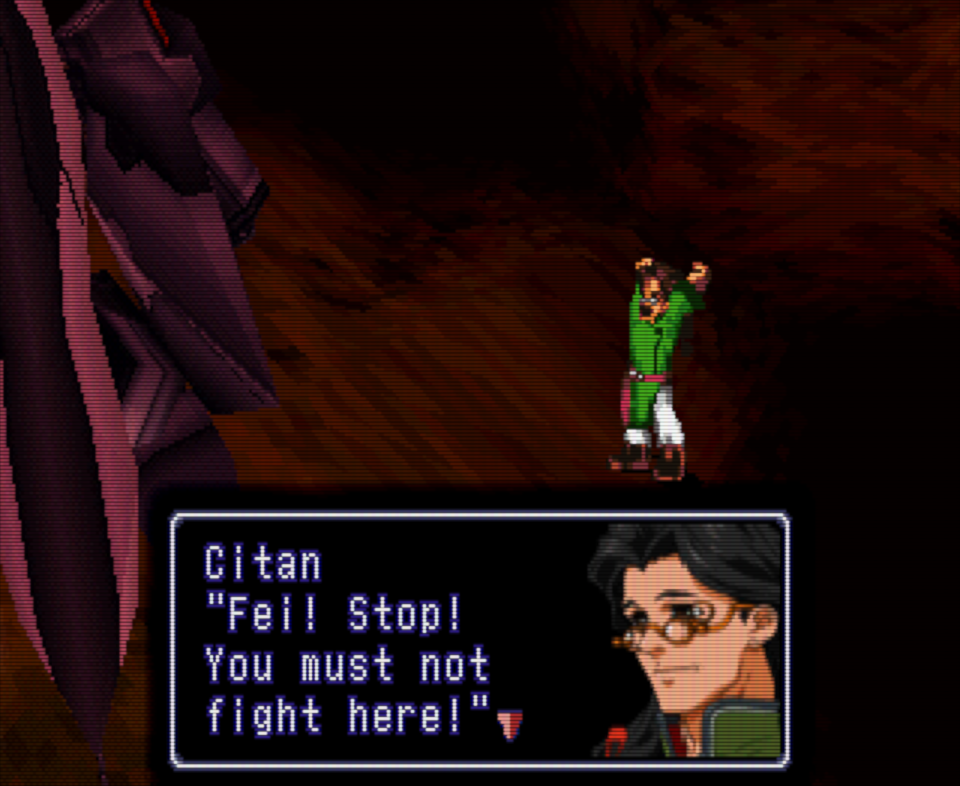
After an emotional deathblow or or two, the story eases off somewhat. But it’s always ready to give you a painful jab to make you wince, or make you question what you know about the world up to this point. If you want a story with a cynical view of religion, where god exists but not in the mystical sense we usually think of him, Xenogears has that. If you want a story where humanity faces an nuanced existential struggle, Xenogears has that too. There are points where we wonder if the people of this world have lives worth living, or if they are indeed just “sheep”?
However, let’s not pretend Xenogears story isn’t fun! The search for the animus relics to transform the gears to the next level reminds of, believe or not, Digimon Adventure. It is very similar to the search for the crests to evolve the Digimon to ultimate level. Most of the game is like that. A journey that is bright and full of character. It is only at key moments, especially towards the end, that the game takes off its gloves. The balance is masterful.
Fans may use words like “love story” describe Xenogears. It is, but only a little bit. It is more of a “father issues story”, and it will hit you hard if you are weak to tales of troubled father-son and father-daughter relationships. Almost every character has a variation of it.
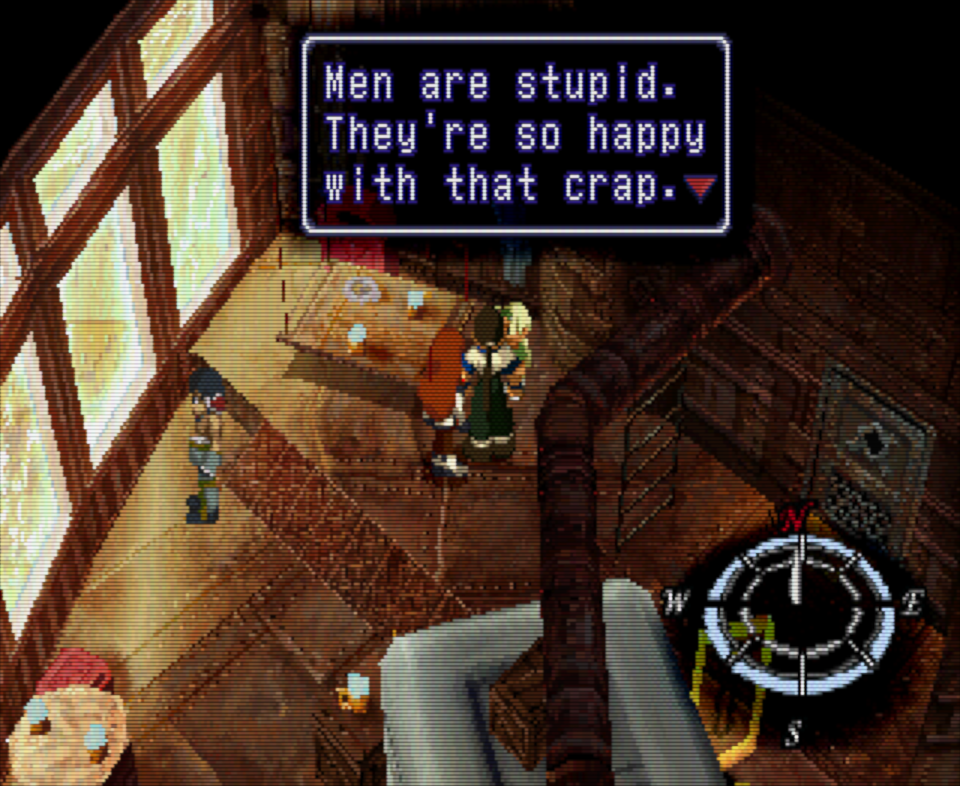
A natural product of the game’s exceptional scope, there are numerous other themes present too. Which the main one? Each player you ask might might have a different answer. Some that stood out to me include:
- Common people exploited by elite castes. Solaris vs. “the lambs”. Nocturne and the prison population.
- Technology used to gain supremacy, even transcending the human condition. The gears. Krelian’s nanomachines. Deus.
- How previous generations form the ties of our destiny, but also how those ties are not unbreakable. Fei and Lacan. The Fatima heritage. The age of the Gazel ministry and their eventual fate.
What else? Revenge. Loss. Reconciliation. Trauma. Xenogears is those sorts of stories. And, yes a little bit of a love story as well.
Unfortunately, the weightiest plot points only emerge in the games truncated second disk, where only a little attention can be given to each issue. Even so, I found the attempt a lot more convincing than in other JRPGs.
It is of comparable quality to the “World of Ruin” half of the Final Fantasy VI story: a plot that delivers on the big ideas it presents, instead of tiptoeing around them. It is a story committed to itself.
Another word I would use to describe it is intricate. It has many subplots that feed into one another. You don’t realise it until the game starts revealing it’s secrets towards the end, but this story really is extremely complex. Do I understand Id’s story even now? Or Grahf’s? Or Elly’s? Miang’s?
I have only played the game once, but I am already certain that if I play it again I will be shocked by the subtle references and foreshadowing I missed.
For something as long, complex and high quality as Xenogears, you would the script must have bee written in detail ahead of time. But it seems this was not the case:
Interviewer: There was a deadline, but the plot wasn’t done yet, it seems.
Tanaka: Takahashi-kun seemed to come up with parts of the world as he went along making the game, so there were times when we didn’t know when we’d see the exit. It might have been better to write up something first, clean and tidy, and go from there, but I think Takahashi-kun had a vision of seeing everything in action, and further expand the world from there.
Hiromichi Tanaka, battle planner for Xenogears (2018 Anniversary Concert Interviews)
If I could sum up the game in a word, as cliche as it sounds, it has to be “epic”. Even in a genre full of epics, Xenogears takes it to another level. So much happens in an average 10 or 15 hours stretch in this game that where the characters were at the start of the game feels like a different life time. By the end of the game the political status of the world is very different. The nature of the conflict is different. I think back to when Fei and Citan were first looking for a way out of the desert after the events in Lahan. There was a small desert town that we never returned to. It seemed consequential at the time, but it was a drop in an ocean.
Speaking of Citan, he is my second favourite character, but it would be too much of a spoiler spoiler to tell you why.
My favourite character is Bart. This cast is full of characters with a dark side. Bart is boisterous and takes action before he thinks, but he is fundamentally good in an uncompromised way.
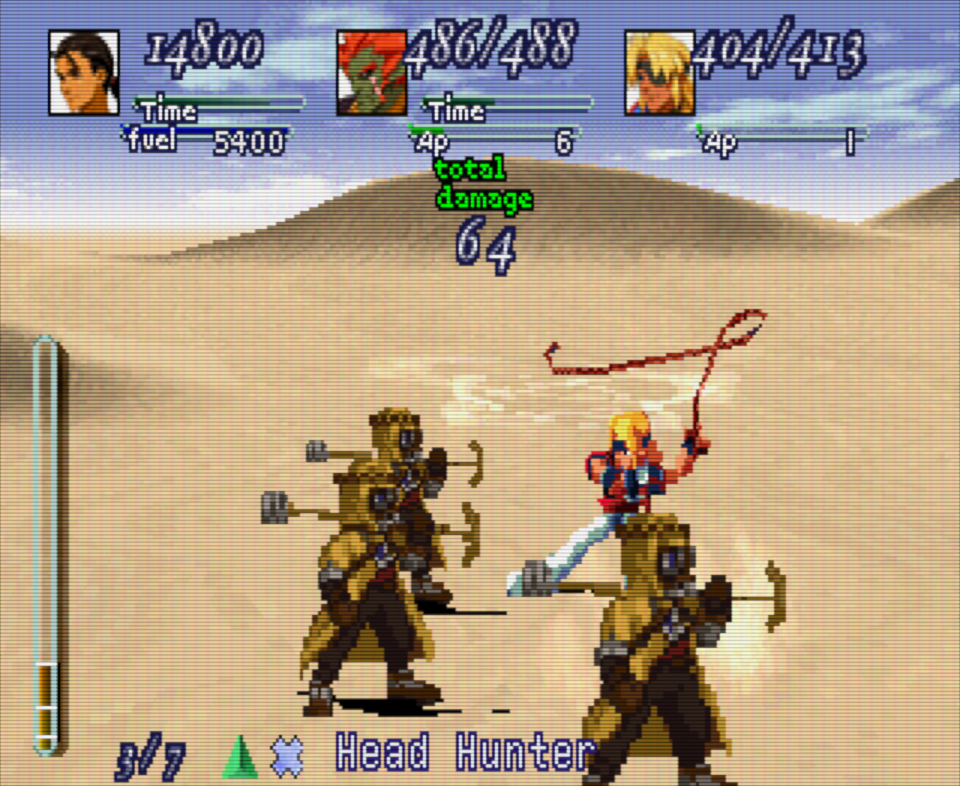
He isn’t the main character, but he is the most traditionally heroic. That contrasts with the anti-hero characters in a way that makes him shine brighter.
A world of fun
Around halfway into the first disk, Xenogears takes a detour. Fei is captured and finds himself confined to prison town with a unique culture. The pecking order in this town is based on “battling”, a formal sport of mech-on-mech combat.
There are many times that Xenogears shocked me, but none more so when I realised that “battling” is a fully-featured, 3D fighting game!
Hiromichi: Yes, we put a lot of stuff in it to make it look like a standalone game. I think that took us about six months.
Takahashi: It was a year.
1998 Interview with Xenogears staff
JRPGs are a balance of repetition and variety. The core gameplay of grindable regular battles is inherently repetitive, but they soften the blow with variety — minigames, dungeon puzzles, gimmick bosses, and so on. But no game achieves the balance quite like Xenogears does.
In other words: this is a long-ass game, but it doesn’t like to repeat itself.
The setpieces are exquisite. Take Bledavik. The goal is in infiltrate the castle, but a distraction is needed. Therefore, the game alternatives control of Bart, who does the breaking in, and Fei, who is part of a tournament, where he puts on a good show to distract the guards. It’s double the excitement, half the chance for the player to get bored.
Later in the game, its you inside a castle, defending an assault on Shevat. A lesser game might have turned this defence scenario into a dungeon: run through the city, fighting random encounters, until you reach the leader, whom you defeat to fend off the assault. Xenogears knows this wouldn’t make sense. Instead, it requires that you split up your characters, choosing which character to defend which side. You fight battles with each of them in turn until the boss arrives.
It seems like a small change, but it is vastly more evocative and memorable. Xenogears understands that not every conflict scenario in a JRPG needs to take the form of a dungeon.

There are many examples of Xenogears choosing to go beyond the obvious JRPG gameplay loops. Even the sewer, that ubiquitous level type that is a joke among gamers, is elevated here: facing off against the sewage-dwelling monster of Nocturne is not unlike a level you might find in an early Resident Evil game.
I could keep going. The anima dungeons have very welcome puzzles. That isn’t a big surprise, as lots of JRPGs has puzzles in these days, but it adds to the variety.
Speaking of puzzles, there are a few decent puzzle battle. Deus is one. So is the following Ramsus fight. Unique battle encounters can set a JRPG apart. Not all JRPGs have them, but Xenogears does okay in this department. Nothing special, but similar to Final Fantasy.
Between the battles and dungeons, you find towns areas worthy of a travelogue. There is never a lazy town, only fleshed out, lived-in locations with carefully considered geography and idiosyncratic visual design.
One town is actually a giant salvage rig floating on the open ocean. You enter from the deck and come across a lift. Facing the controls, you see there are six floors you can visit! But once you start moving through them, you realise they are all connected in a corkscrew pattern.
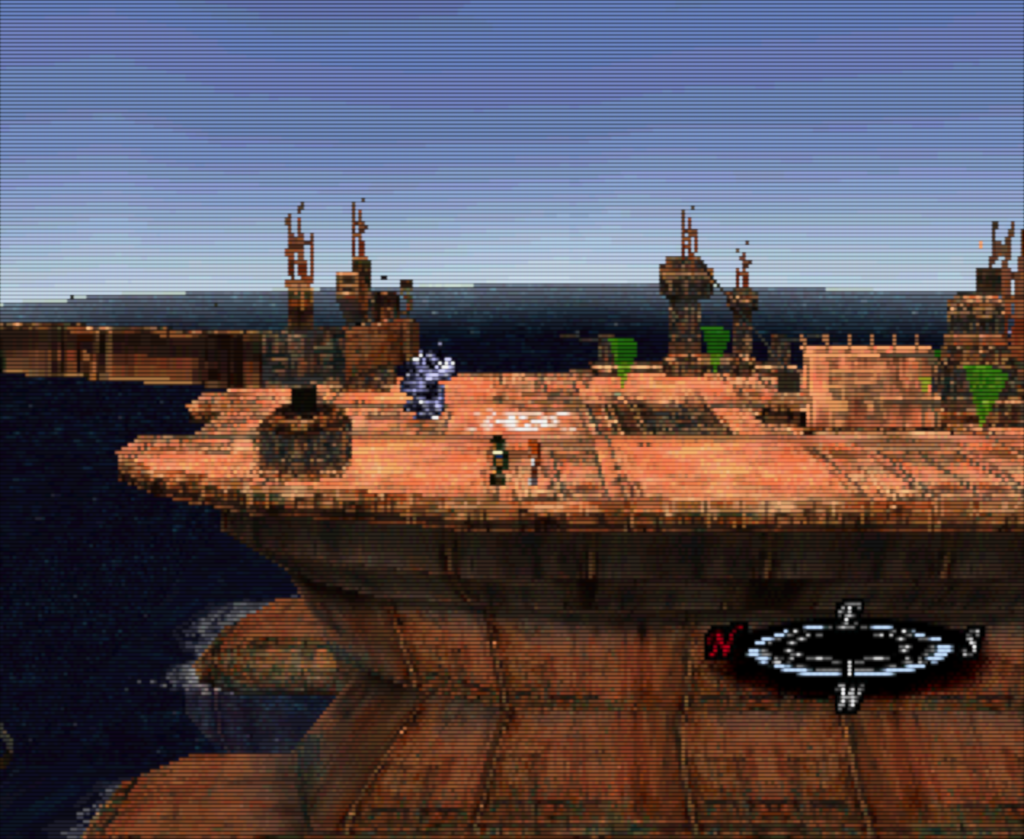
Another town floats above the map, and when you enter the residential area you are wrapped you in relaxing music that makes exploration feel easy. Stone bridges crisscross above and below you, and there are many nooks and crannies to pry into.
Then, you enter the palace where you find a library library packed with a history of the world that you won’t find anywhere else. All the people you meet all have their own perspectives on wars long past and tribulations yet to occur.
Even how you explore each town feels distinct. In one late-game city, it involves taking floating platforms to reach people’s tiny, oppressive cell-like abodes.
At times, Xenogears seem to have the fidelity and charm of a point and click adventure game. Towns with lots of detail to add realism. Nooks, crannies and secrets to find. Distinct areas with unique atmosphere. Minor characters everywhere, ready to tell you a piece of the story.
There are two towns that stand out to me. Kislev’s prison block; and Solaris, the main enemy city. In both urban areas, you come into contact with people you don’t understand, following rules that you haven’t been introduced to. It takes time to acclimatise, which is the sign of a well designed fictional culture.
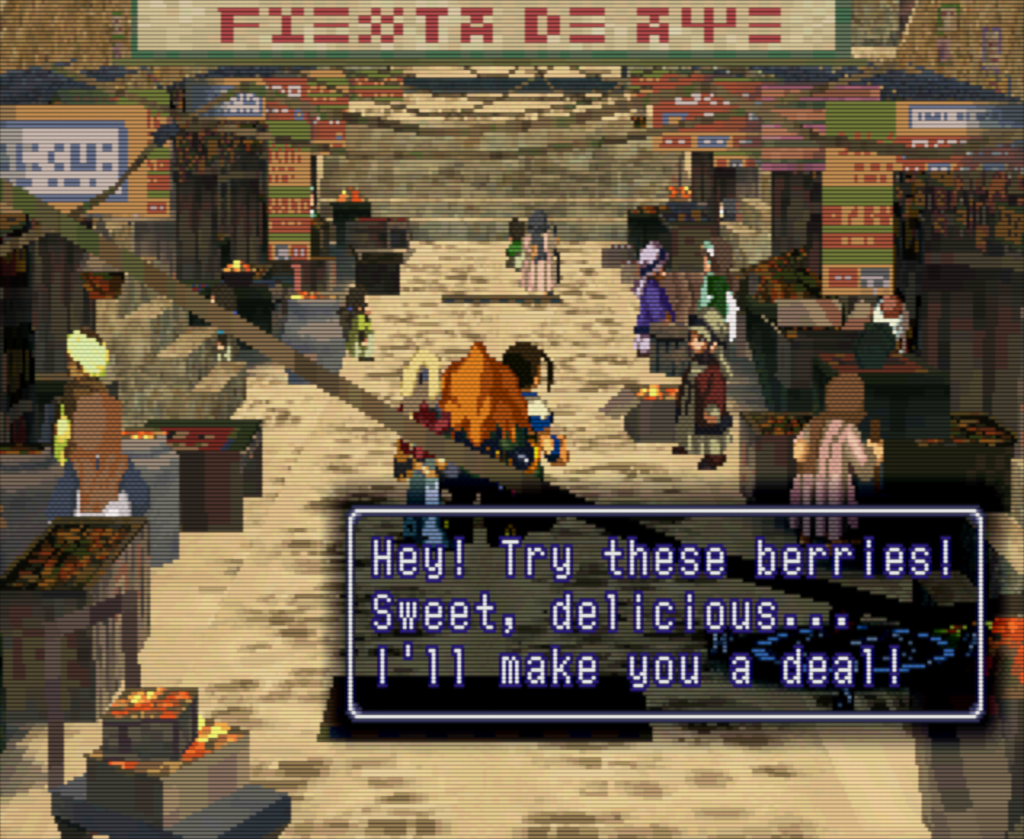
Every location was truly designed for you to enjoy being there. It makes believe strongly that there are variety of types of people that exist in this world, and that makes the world feel vast.
A sense of scale
In the Stalactite cave, where you get lost early in the game, you are piloting your mech and find a switch you need to pull. It is not a mech sized switch, but a human sized one. You jump out of cockpit. From this perspective, which is calibrated to the size of a giant robot, your character is tiny!

It’s almost like I’m playing Blaster Master.
Scope and scale and keywords for the JRPG genre, adventures in which you circumnavigate the globe and sometimes go into space. Since the NES era, they have had a reliable bag of tricks to create the illusion of scale. From smaller to larger, different screens showed the world from different perspectives: a battle screen, a town and dungeon screen, and a world map.
By 1998, those techniques were long in the tooth, and PS1 JRPGs were innovating for the 3D era. Just as Final Fantasy VII and Xenogears branched away from one another when it came to visual presentation, each games also had their own new methods of conveying scale.
In Final Fantasy VII, scale is increased at the small level, though detail. You see the grime in the slums of Midgar, you see the ramshackle state of their streets, all careful conveyed in hand-crafted, pre-rendered backgrounds. The world feels big because you can see it in greater resolution than ever before.
Xenogears does something different. It adds new, intermediate levels of scale. The “mech” perspective, in which your character is ant-sized, is one example. Zoom out further, and you find that the transition from town map to world map is blurred with the addition of a city screen that helps you better appreciate the size of these large settlements.
As a result, Nisan feels like a much bigger and more realistic location than, say, Kalm, even though the playable space of each is a similar size (a few shops, a few houses).
Another Xenogears city is Bledavik, the capital city of Aveh:
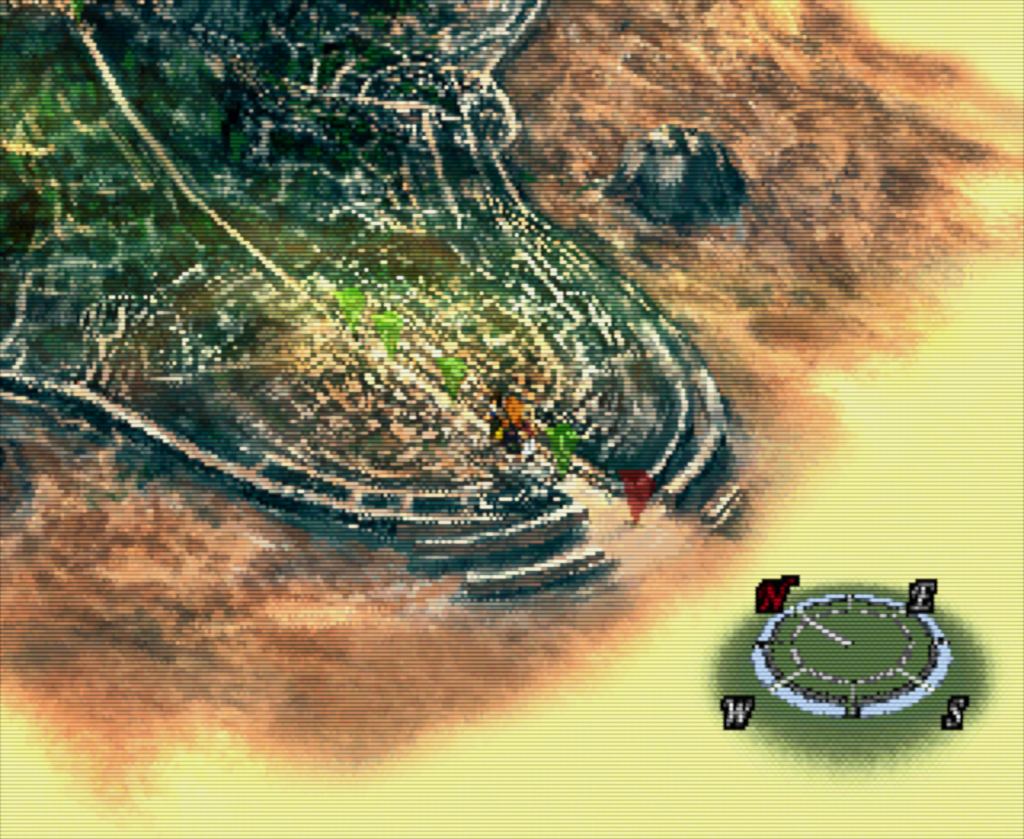
When you arrive there, a festival is taking place. It’s not as packed with side-activities as the festival in Chrono Trigger, but it was enough to remind me of it. There are loads of nice details here. One stuck in my mind. A man outside a tent gives you a balloon, then you exit this area to a city map. Then, on the city screen, you see your little balloon float away into the sky! Brilliant.
Let’s zoom out again. Back on the world map, there are structures that look enormous! We have developed an intuitive sense of what the city-sized world map object really represents. So when we see something many times bigger, like the Babel Tower, we are awed! When we enter the tower, the sense of enormity is maintained, as this is by far the largest interior location on Disc 1 — and that’s from the perspective of a mech!
World maps would eventually fade from JRPGs, making Xenogears one of the last games in the genre to develop new ideas for it. In this way, Xenogears feels both classic and innovative, the height of a defunct artistic style. It truly would have made an excellent FF7 in another dimension.

There’s one more perspective to look at: the battles. You learn early on that there are two types of battle in Xenogears: battles on foot, with your 2D spite characters, and battles in your 3D mechs. They have slightly different mechanics, presentation, and seem to be entirely unrelated to one another.
The two battles types seem to be entirely separate entities. The level of damage is different by an order of magnitude. The user HUD is different. And of course, the mechs are so much larger than the humans, it would only make sense for them to fight mech sized enemies.
Then there was another Xenogears moment that blew my mind. As escaping the Kislev prison, and regaining your mechs, a new option becomes available in battles: summon mech. You can do this in any outdoor battle. You can do it for one character at a time, so that your party consists of a mix of mechs and humans. You can summon three mechs against an enemy party of rabbits. Yes, you do comically overwhelming damage to them, 1000+ per hit against enemies that have 50 health. The point is, these two battle systems were never separate, just two halves of the coin. That means you can really feel the gigantic size and power of your machines, and conversely the powerlessness of your human characters even they happen to stumble into an encounter with an enemy far too big for them (there is at least one area of the game that makes this likely).
Your first thought might be that this sounds terribly imbalanced, but it’s not. Most story scenarios are built to be played in a mech (wide open spaces) or as a human (narrow interior spaces where the mech cannot be summon). The majority of the game is story scenarios, so it’s never an issue.
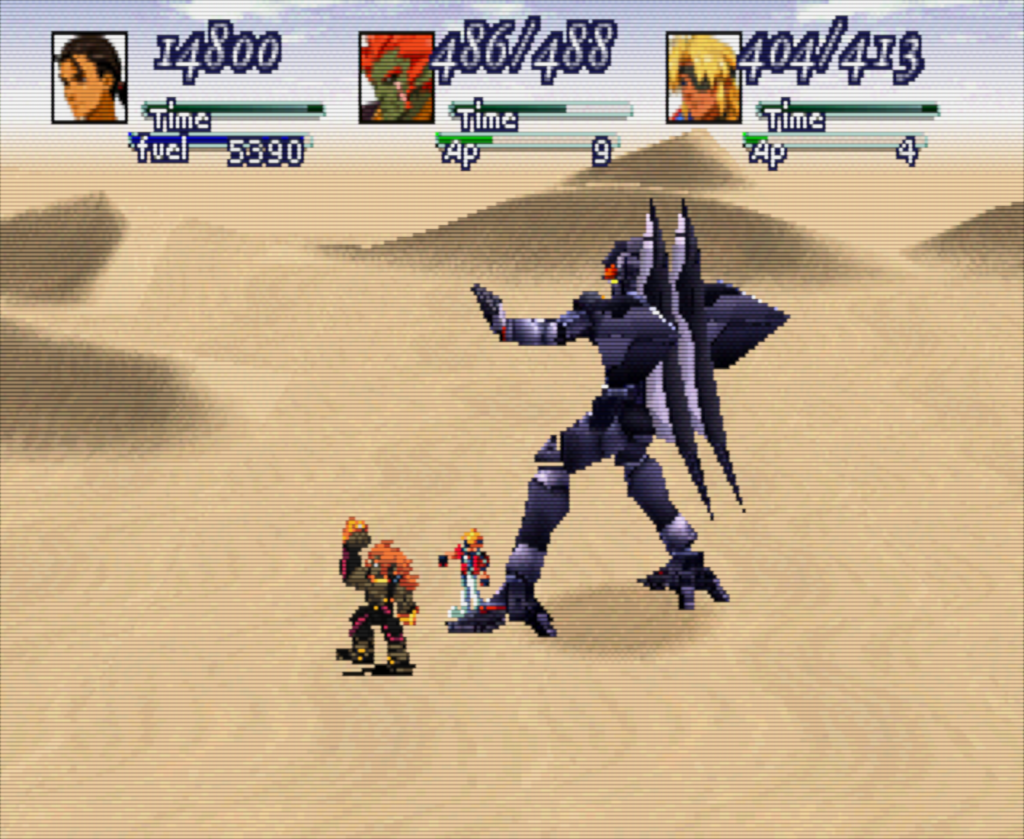
But the fact that mixed mech/human battles are possible, occuring at two vastly different scales at once, is awesome.
A battle system
It was over 30 hours into the game that I first had to make a tactical choice regarding battle. I equipped items to my mechs to reduce fire damage to stop Shakam incinerating me.
The Xenogears is a traditional system with physical attacks, elemental magic, buffs and debuffs — all the building blocks of a strong battle system,
Yet it never quite coalesces into a tactical experience because the only effective damage dealing option is to use back-to-back “deathblows”.
Deathblows are made up of a combination of light, medium and strong physical attacks. Light attacks are more likely to hit the enemy, but do less damage, and the opposite is true of strong attacks, and you can do a sequence of these attacks in one turn.
It’s an original idea for a JRPG, borrowed from fighting games, and a nice one at that. In a genre sometimes ridiculed for the ability to spam the first attack in the menu to win, making your physical fighting options more complex is a truly appreciated innovation.
At the end of your sequence of attacks, you perform the deathblow, if you’ve learned that technique and if you’ve followed the prompts at the bottom of the screen (or memorised the sequence).

These attacks are some of the most visually interesting moments in a game jam-packed with visually interesting moments. A personal favourite deathblow is Citan’s “Myogetsu”, in which he appears to pogo stick off the enemy’s head using his sword, Zelda II style. The later deathblows get even more flashy and intricate, such as Billy’s “Holy Gate” or Citan’s “Haze of Fire”.
Unfortunately, deathblows are more exciting visually than they are engaging tactically. They deal a lot of damage with no downside, so will be your primary method of attack from the start of the game until the end.
It is, however, quite addictive to train for new deathblows.
Almost all JRPGs give you money and experience after a battle, but the good ones give you something else to work towards. For Xenogears, this something is deathblow experience, obtained by performing different physical attacks in battle. Each character has four light attacks, two medium attacks, and just one heavy attack. Each attack type gives a type of experience towards new deathblows attacks.
As deathblows are the primary way of becoming more effective in battle, it became enjoyable to get into random encounters to figure out what sequence of attacks will train my next deathblow, and spam it in as many subsequent battles as possible.
It even made Xenogears irritatingly high random encounter rate quite sufferable.
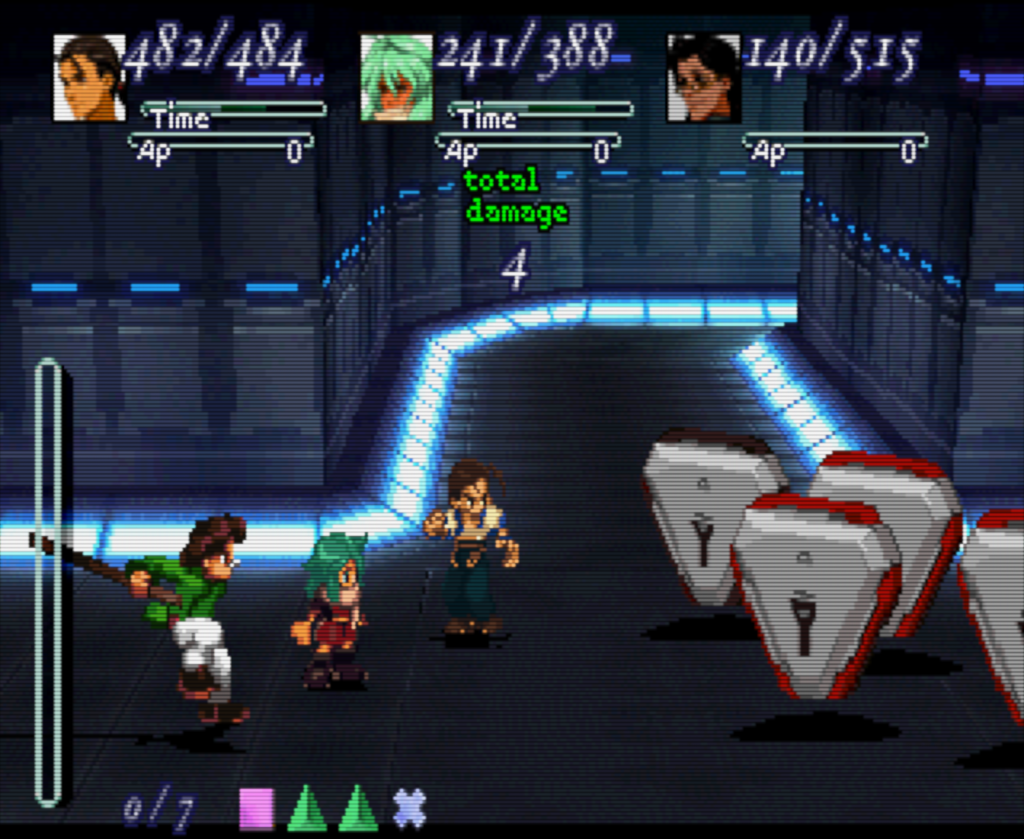
I have one more thing to mention about the battle system. Towards the end of the first disk, Citan starts using a sword instead of his fists. After that, Citan has a whole different set of deathblows! What exceptional attention to detail.
An imperfect game
I’m not going to say that Xenogears is for everyone. I want to warn you about a few things before you get overhyped and then blame me for playing something that didn’t transcend reality.
If you get confused by the story, I can’t blame you or act surprised. I felt lost at multiple points. There are multiple antagonists and it won’t be clear for a long time how they are related or what each of their motivations are. There are many factions, something I usually love in a story, but only if I know a bit about them. We go from getting involved from one faction to another and it’s not clear how some of those scenarios relate to one another.

It’s a jam packed story and there is always something interesting driving events forward, but you don’t always get any view on the bigger picture, and that can make it hard to get engaged with.
Minor storytelling irritations aside, the main thing I don’t like about this game is the speed. Many actions in this game execute with a delay:
- Opening the menu
- Scrolling text
- Walking through a door
- Entering battle
- Completing attack animations
It’s a drag. In a remaster the first thing needed is to cut out these dead seconds. Faster loading, shorter gaps between attacks, faster text, and maybe a speed up button.
Remember, this is a 60+ hour game. There’s no question about it: if you are prone to impatience, Xenogears is going to challenge you.
On the other hand, if you’re into JRPGs for the music, let assure you that the work of Yasunori Mitsuda, of Chrono Trigger fame, does not disappoint… except in one way: there just isn’t enough of it. There are 44 tracks (compared to Chrono Trigger’s 64) and there are about four in particular that you will hear very regularly. It’s a testament to the exceptional quality of those tracks that I never tired of hearing them, but more variety would have been better.
Some other things that could have been refined:
The random encounter rate in a few areas is way too high. The last dungeon was the most frustrating example, but it’s not the only one.
The camera can be an annoyance, or rather the scenery isn’t always designed in a way that works best with the isometric camera, so you vision might be blocked from some , or it is hard to get a clear sight with an angle that makes it easy to make a jump.
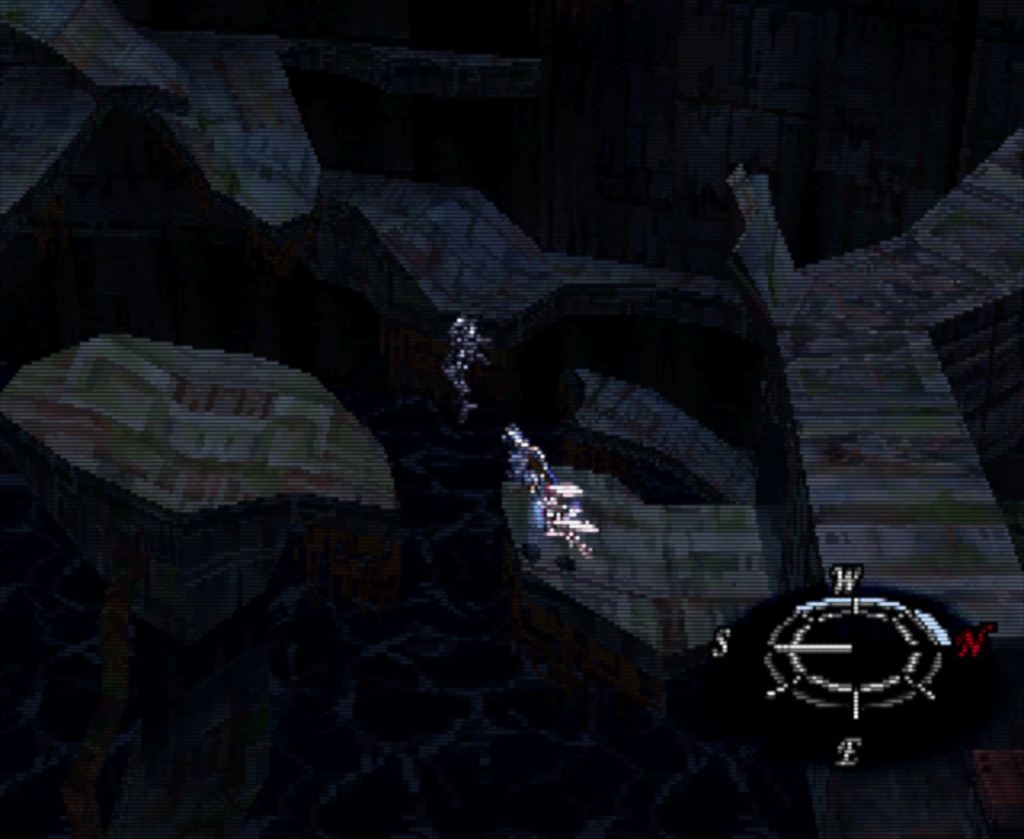
Speaking of jumping, many players people hate the platforming. However, frankly, there’s hardly any of it, nowhere near enough for me to hold it in contempt in my memory. It’s only significant in one dungeon (Babel), and I can’t even say I dislike that dungeon overall. It is supposed to be a ruin, the platforming just helps emphasise that this is not a place that exists for your convenience.
Being able to jump just makes the expiration more varied, usually, and more JRPGs could learn from this.
Okay, rounding out the negatives, let’s talk about Disk 2.
Xenogears is a two disk game. The first disk is a 40 or 50 hour typical JRPG journey, with it’s own minor climax. The big mysteries of the game are still unanswered at this point. In fact, you could say that Disk 1 is a massive, multifaceted set-up arc, and all the events with the biggest consequences (those on a global and cosmic scale, as you might put it in comic-book terms) are set to occur in Disk 2.
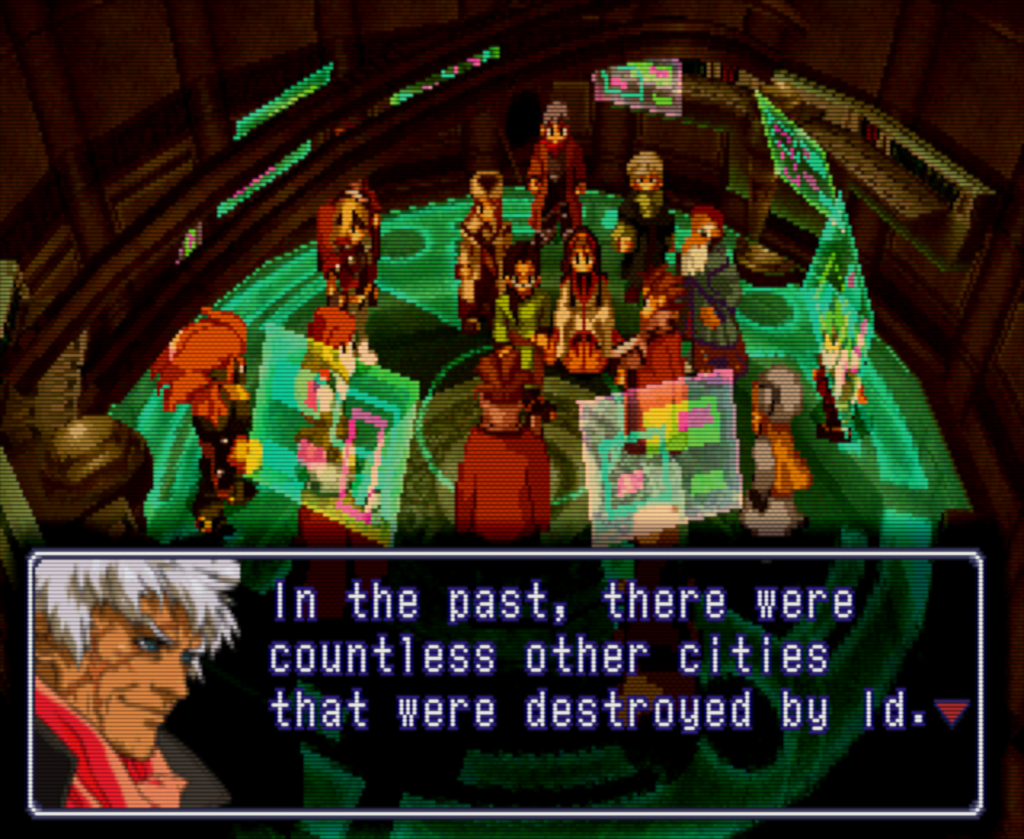
However, Xenogears vast scope did not fit into Square’s development cycle, which was supposed to take something like 1.5 years in the late 90s. Xenogears had an extension to 2 years, but finishing the whole story in this time was impossible.
Takahashi could choose to finish the game at the end of Disk 1, but he took a different path: rush through the remaining story in a JRPG-storybook hybrid.
It’s not just a change in how the story is presented. If the game’s story became a novel, similar amounts of dialogue, a similar level of detail and pacing, but without the gameplay sections, I wouldn’t have minded so much.
Instead, events that would have taken a great deal of dialogue to build up if they had occurred in Disk 1 — spreading the nanomachines to remove the seal limiter from the population, or finding and activating the Norturne mega-mech, events of global consequence — are just thrown at you in a few lines of text!
It’s pretty comical and bad.
It starts to come together again at the end, for a hour or two before the final fight, when you get access to a world map again. For that reason, I thankfully don’t have to say that the game ends on a low.
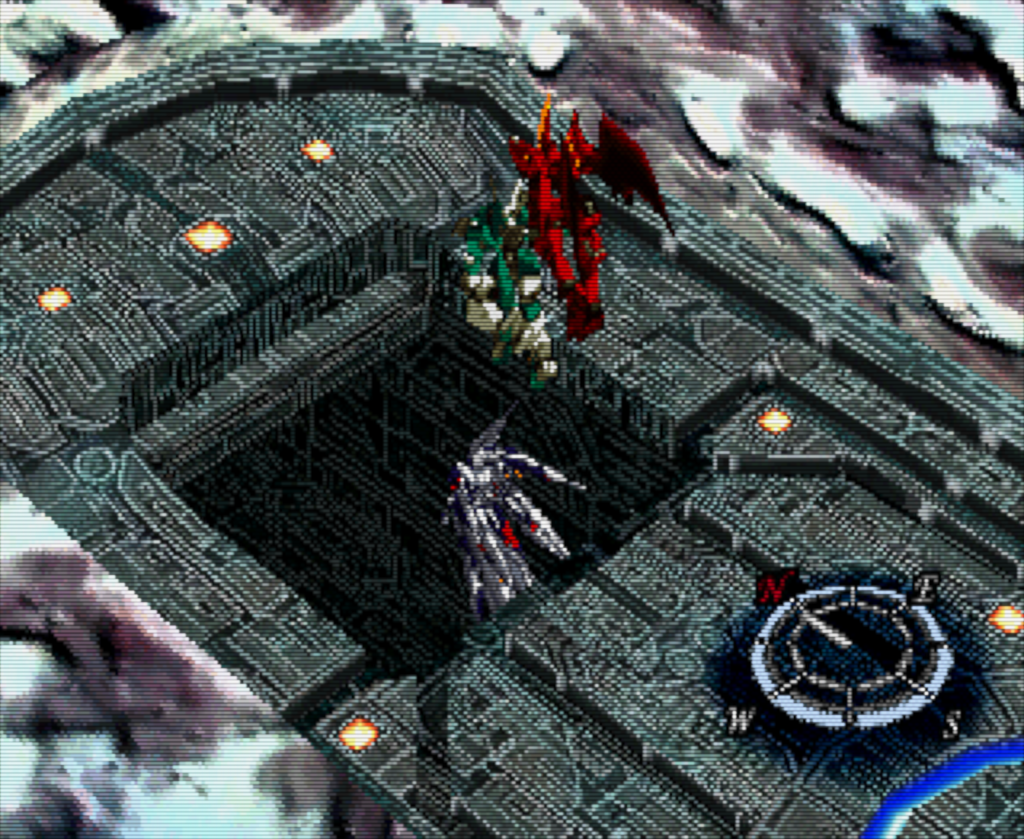
It’s a decent ending, we just don’t get there in the best way. The rest of Disk 2 is just the silhouette of an incredible story. Therefore, you have to go into Disk 2 with low expectations.
Conclusions
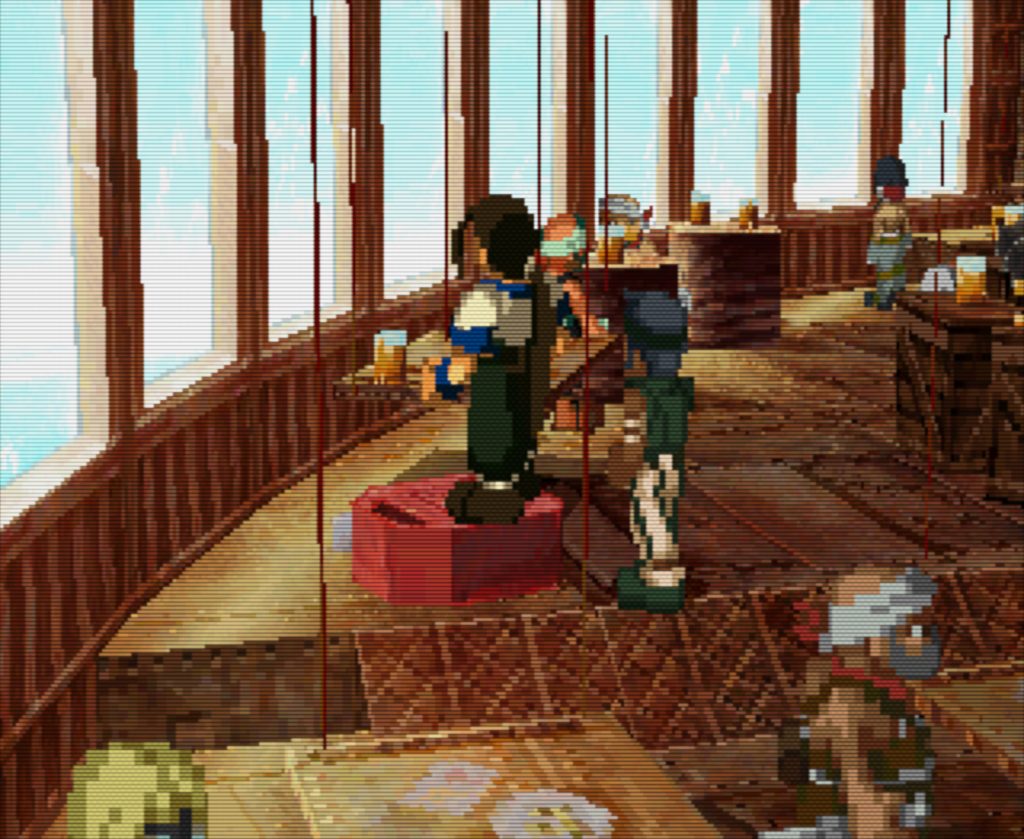
Xenogears is exceptional and unique. At it’s core, it was born of the minds of exceptionally well-read and ambitious writers, and for two years they were given the resources and talent of the Final Fantasy series in it’s golden age, and the freedom to make the game they wanted despite it’s complexity and weirdness and an unrealistic scope. That is a combination that is rare in videogames.
Xenogears is a game you can go in-depth on, if you are so included. Take the Xenogears and Xenosaga Study Guide, for example. The writer sometimes shows disdain for the “immature consumers of popular media” who see Xenogears as “just” another JRPG classic like Chrono Trigger and Final Fantasy VII, instead of the Russian literature of our generation — an attitude that I find off putting. But I have to admire his or her dedication to the series, and consider it a point of merit for the work that that it can inspire such dedication.
I’ve only played Xenogears once. I am confident that if I play it again, I will be struck my how much of I missed or misunderstood.
I do not believe there will ever be a finished version of Xenogears. Therefore, the game leaves us us sad, something full of wasted potential. A marred magnum opus. Elation and sadness: these are essential to the Xenogears experience. It could have been the best story ever told in a videogame (some people say it still is). It being unfinished is part of the rich metastory of the work… but I would prefer to have the tales of Fei, Elly and Bart told in full.
Xenogears was also inspired by Star Wars. Grahf is Xenogears version of Darth Vader, Cain the Emperor, the chasing Gebler forces in their battleships equivalent to the Empire’s Star Destroyers. Star Wars, too, had a unique and compelling metastory, one of a convoluted untold history (before the prequels were released), and eventually disappointment (after the prequels were released). That is essential to the Star Wars experience.
The same again: Evangelion, that ran out of money and had a finale composed of mainly still images. It was eventually corrected by a movie, but the episode 25/26 disappointment is part of the metastory of the franchise. A quirk that makes it more fascinating to us.
Inspired by Star Wars, Takahashi intended Xenogears to be the middle part of his story. Multiple prequels (not necessarily games) should have filled in events that are only hinted at in Xenogears: Episode V, such as the previous incarnations of Fei going back 1000 years or more. A sequel, Episode IV, would have wrapped up the story and the universe.
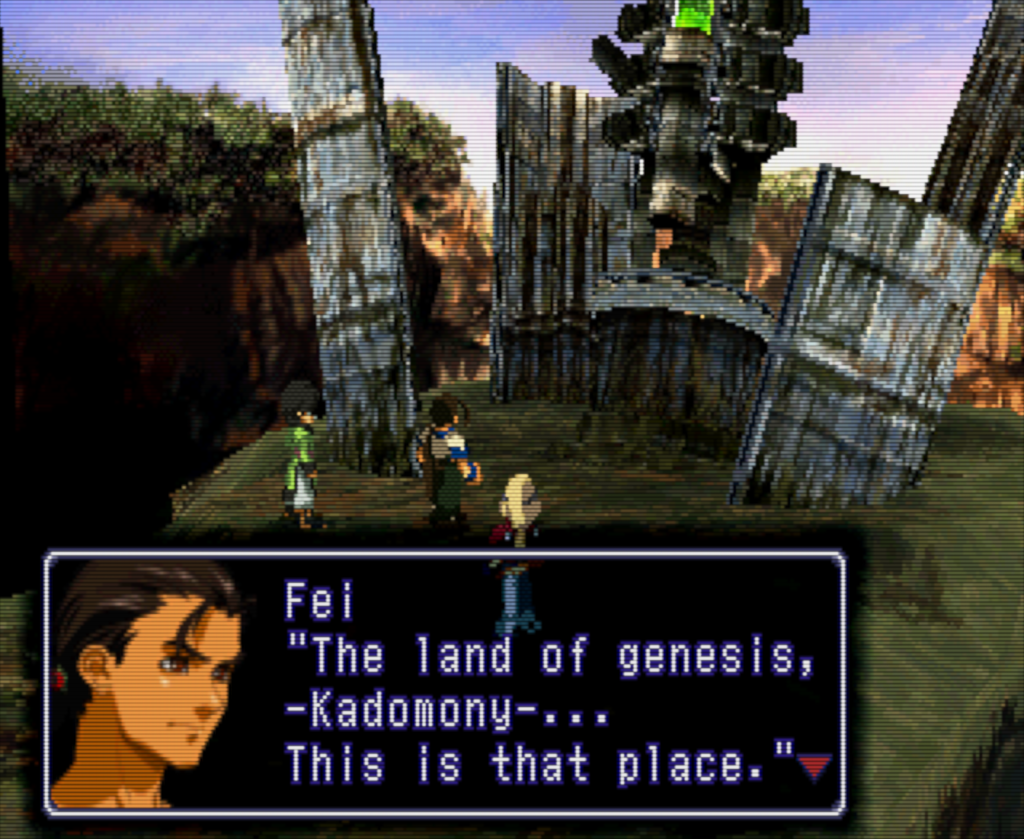
That never happened, and never will. But the ideas for the first of those prequels was spun off into a new franchise, Xenosaga. Thought it might be some time before I get to playing it, what I hope to get from it when I do it is reassurance: that the ideas of Xenogears lived on, in some form, and that it become something close to the multi-game, space-spanning epic that it always deserved to be.